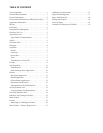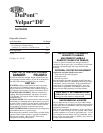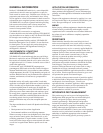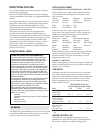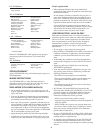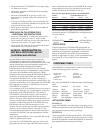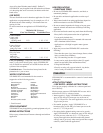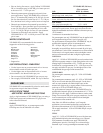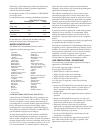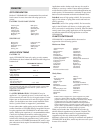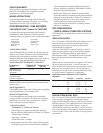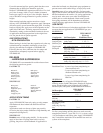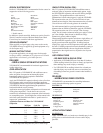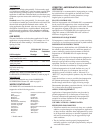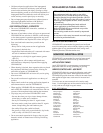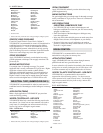
followed by a layby treatment, provided at least 60 days have
elapsed and 3 inches of rainfall or sprinkler irrigation have
occurred since the first treatment.
Do not apply more than 2 1/3 lb of DuPont™ VELPAR® DF
per acre per season.
Use the following rates according to the different soil textures:
VELPAR® DF (Lb/Acre)
Soils Preemergence + Layby
Coarse
Texture
*
Sandy loam 1/3 1/3
Medium
Texture
Loam, silt loam 9/10 9/10
Fine
Texture
Clay loam 1 1/3 1 1/3
*With at least 2% organic matter
On dormant cane, a surfactant may be added to the spray
mixture to increase control of emerged weeds.
WEEDS CONTROLLED
VELPAR® DF is recommended for the control or
suppression of the following species:
* Partial control
TANK MIXTURES (LOUISIANAAND TEXAS)
A tank mixture of VELPAR® DF at 0.67 pounds per acre
plus diuron (“Karmex” DF or “Direx” DF) at 2.25 lbs per
acre may be applied to newly planted sugarcane prior to
crop emergence or to rattoon (stubble) sugarcane following
harvest for improved control of annual sedge, cutleaf
eveningprimrose, red morningglory, pitted morningglory,
Texas panicum, smellmelon, swinecress, toadflax and also
provide additional suppression of itchgrass.
An early Spring application of the tank mix combination
may be used postemergence (over the top) of sugarcane
until it reaches a height of 18 inches. If weeds are present at
the time of application, a non-ionic surfactant at the use rate
of 0.25% V/V or a crop oil concentrate at the use rate of 1%
V/V is recommended. If a tank mix partner is being used,
follow the most restrictive adjuvant recommendation.
Temporary crop chlorosis may result from postemergence
applications to emerged sugarcane.
The tank mix combination may also be used as a post-
directed/layby application. For best weed control, post-
directed/layby applications should be made prior to weed
germination. Post-directed/layby applications are required
when the sugarcane plants reach or exceed a height of 18
inches. Post-directed/layby applications should be directed
at the base of the sugarcane plants so the spray does not
contact green leaves or the plant whorl.
If weeds are present at application, a tank mixture partner,
labeled for use on sugarcane, is recommended. When
adding other tank mix partners, read and follow all use
instructions, warnings and precautions on the companion
label(s).
Do not apply as a postemergence (over-the-top) application
to sugarcane beyond a height of 18 inches.
The tank mix combination of VELPAR® plus diuron may
be applied to fallow sugarcane fields up to 60 days prior to
planting. For best results, applications should be made to a
newly prepared seedbed that is free of clods and existing
vegetation. If weeds are present, either a separate
application of a contact herbicide or a tank mix partner is
recommended for improved postemergence control.
USE PRECAUTIONS - SUGARCANE
Do not plant any crop other than sugarcane following an
application of VELPAR® DF.
Do not feed sugarcane forage to livestock.
Do not apply VELPAR® DF:
•Within 180 days of harvest in Hawaii.
•Within 234 days of harvest in Louisiana.
•Within 288 days of harvest in Puerto Rico.
•Within 234 days of harvest in Texas.
To avoid injury to sugarcane, observe the following
precautions:
• Do not use VELPAR® DF on cane that shows poor vigor
because of insect damage, disease, or winter injury, or
shows symptoms of other stress conditions such as
drought stress.
• Do not add a surfactant in applications unless otherwise
specified.
• Do not use VELPAR® DF on gravelly or rocky soils,
thinly covered subsoils, or coarse-textured soils (sands to
sandy loams) with less than 1% organic matter.
•Temporary chlorosis of the crop may result from
application over emerged cane. Applications during active
cane growth should be directed to cover the weeds and
soil while minimizing crop contact.
• Do not use VELPAR® DF on varieties known to be
susceptible to weed killers.
Extremely heavy rainfall after application may result in
poor weed control and/or crop injury, especially if the
application is made to dry soil.
Ageratum*
Alexandergrass
Amaranth (slender,
smooth)
American burnweed
(fireweed)
Balsam apple
Barnyardgrass
Bermudagrass*
Carolina geranium
Chickweed
Crabgrass (hairy, large,
smooth)
Crotalaria (fuzzy, showy)
Cuphea (tarweed)
Dallisgrass
Fingergrass (radiate,
swollen)
Flora’s paintbrush
Foxtail (bristly, yellow)
Goosegrass
Guineagrass
Henbit
Itchgrass*
Jobs tears
Johnsongrass (from seed)
Jungle rice
Lambsquarter
Morningglory (hairy,
threelobe)
Mustard (wild)
Oxalis
Panicum (brownleaf,
browntop, Texas millet)
Paspalum (ricegrass, sour)
Pigweed (common,
smooth)
Popolo
Purslane
Sandbur
Sensitive plant (hila hila)
Signalgrass (broadleaf)
Sowthistle
Spanish needle
Sprangletop
Spurge (prostrate,
graceful)
Sunflower
Vaseygrass
Waltheria (hialoa)
8



